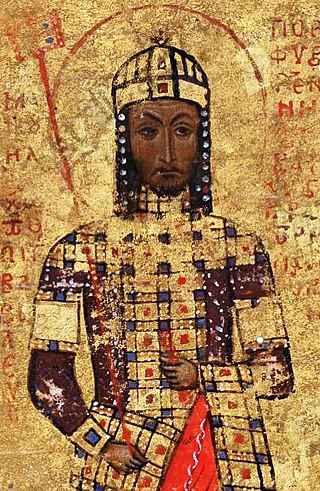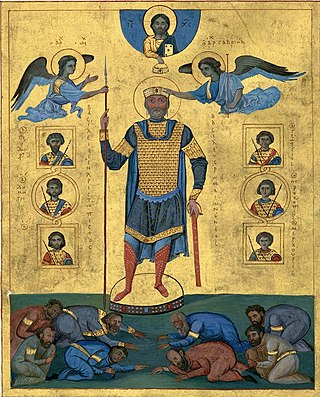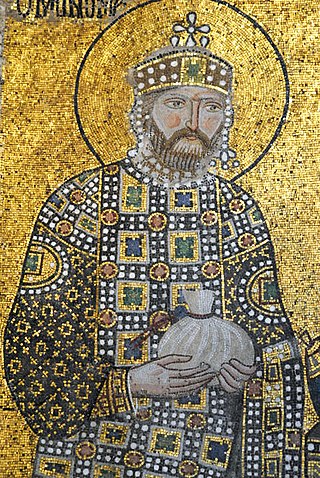
Justinian I, also known as Justinian the Great, was the Eastern Roman emperor from 527 to 565.

Manuel I Komnenos, Latinized Comnenus, also called Porphyrogennetos, was a Byzantine emperor of the 12th century who reigned over a crucial turning point in the history of Byzantium and the Mediterranean. His reign saw the last flowering of the Komnenian restoration, during which the Byzantine Empire had seen a resurgence of its military and economic power and had enjoyed a cultural revival.

Basil II Porphyrogenitus, nicknamed the Bulgar Slayer, was the senior Byzantine emperor from 976 to 1025. He and his brother Constantine VIII were crowned before their father Romanos II died in 963, but they were too young to rule. The throne thus went to two generals, Nikephoros Phokas and John Tzimiskes before Basil became senior emperor, though his influential great-uncle Basil Lekapenos remained as the de facto ruler until 985. His reign of 49 years and 11 months was the longest of any Roman emperor.

Michael VI Bringas, called Stratiotikos or Stratioticus or Gerontas, reigned as Byzantine emperor from 1056 to 1057.

The Battle of Manzikert or Malazgirt was fought between the Byzantine Empire and the Seljuk Empire on 26 August 1071 near Manzikert, theme of Iberia. The decisive defeat of the Byzantine army and the capture of the Emperor Romanos IV Diogenes played an important role in undermining Byzantine authority in Anatolia and Armenia, and allowed for the gradual Turkification of Anatolia. Many Turks, travelling westward during the 11th century, saw the victory at Manzikert as an entrance to Asia Minor.

The Roman emperor was the ruler and monarchial head of state of the Roman Empire during the imperial period, starting with the granting of the title augustus to Octavian in 27 BC. The emperors used a variety of different titles throughout history. Often when a given Roman is described as becoming emperor in English, it reflects his taking of the title augustus and later basileus. Another title often used was caesar, used for heirs-apparent, and imperator, originally a military honorific. Early emperors also used the title princeps civitatis. Emperors frequently amassed Republican titles, notably princeps senatus, consul, and pontifex maximus.

Constantine VII Porphyrogenitus was the fourth Byzantine emperor of the Macedonian dynasty, reigning from 6 June 913 to 9 November 959. He was the son of Emperor Leo VI and his fourth wife, Zoe Karbonopsina, and the nephew of his predecessor Alexander.

Constantine IX Monomachos reigned as Byzantine emperor from June 1042 to January 1055. Empress Zoë Porphyrogenita chose him as a husband and co-emperor in 1042, although he had been exiled for conspiring against her previous husband, Emperor Michael IV the Paphlagonian. The couple shared the throne with Zoë's sister Theodora Porphyrogenita. Zoë died in 1050, and Constantine continued his collaboration with Theodora until his own death five years later.

Byzantine Greece has a history that mainly coincides with that of the Byzantine Empire itself.
The Treaty of Devol was an agreement made in 1108 between Bohemond I of Antioch and Byzantine Emperor Alexios I Komnenos, in the wake of the First Crusade. It is named after the Byzantine fortress of Devol. Although the treaty was not immediately enforced, it was intended to make the Principality of Antioch a vassal state of the Byzantine Empire.

The Komnenian restoration is the term used by historians to describe the military, financial, and territorial recovery of the Byzantine Empire under the Komnenian dynasty, from the accession of Alexios I Komnenos in 1081 to the death of Andronikos I Komnenos in 1185. At the onset of the reign of Alexios I, the empire was reeling from its defeat by the Seljuk Turks at the Battle of Manzikert in 1071. The empire was also being threatened by the Normans of Robert Guiscard, who were invading the Balkans from their base in southern Italy. All this occurred as the empire's military institution was in disarray and had grown increasingly reliant on mercenaries. Previous emperors had also squandered the large gold deposits of Constantinople, so the defense of the empire had broken down, and there were few troops to fill the gaps.

The Byzantine economy was among the most robust economies in the Mediterranean for many centuries. Constantinople was a prime hub in a trading network that at various times extended across nearly all of Eurasia and North Africa. Some scholars argue that, up until the arrival of the Arabs in the 7th century, the Eastern Roman Empire had the most powerful economy in the world. The Arab conquests, however, would represent a substantial reversal of fortunes contributing to a period of decline and stagnation. Constantine V's reforms marked the beginning of a revival that continued until 1204. From the 10th century until the end of the 12th, the Byzantine Empire projected an image of luxury, and the travelers were impressed by the wealth accumulated in the capital. All this changed with the arrival of the Fourth Crusade, which was an economic catastrophe. The Palaiologoi tried to revive the economy, but the late Byzantine state would not gain full control of either the foreign or domestic economic forces.

The Byzantine Empire was ruled by emperors of the Komnenos dynasty for a period of 104 years, from 1081 to about 1185. The Komnenian period comprises the reigns of five emperors, Alexios I, John II, Manuel I, Alexios II and Andronikos I. It was a period of sustained, though ultimately incomplete, restoration of the military, territorial, economic and political position of the Byzantine Empire.
Nikephoros Bryennios the Elder, Latinized as Nicephorus Bryennius, was a Byzantine Greek general who tried to establish himself as Emperor in the late eleventh century. His contemporaries considered him the best tactician in the empire.

The Byzantine Empire was ruled by emperors of the Angelos dynasty between 1185 and 1204 AD. The Angeloi rose to the throne following the deposition of Andronikos I Komnenos, the last male-line Komnenos to rise to the throne. The Angeloi were female-line descendants of the previous dynasty. While in power, the Angeloi were unable to stop the invasions of the Turks by the Sultanate of Rum, the uprising and resurrection of the Bulgarian Empire, and the loss of the Dalmatian coast and much of the Balkan areas won by Manuel I Komnenos to the Kingdom of Hungary.

The Byzantine Empire was ruled by emperors of the dynasty of Heraclius between 610 and 711. The Heraclians presided over a period of cataclysmic events that were a watershed in the history of the Empire and the world. Heraclius, the founder of his dynasty, was of Armenian and Cappadocian (Greek) origin. At the beginning of the dynasty, the Empire's culture was still essentially Ancient Roman, dominating the Mediterranean and harbouring a prosperous Late Antique urban civilization. This world was shattered by successive invasions, which resulted in extensive territorial losses, financial collapse and plagues that depopulated the cities, while religious controversies and rebellions further weakened the Empire.

This history of the Byzantine Empire covers the history of the Eastern Roman Empire from late antiquity until the Fall of Constantinople in 1453 AD. Several events from the 4th to 6th centuries mark the transitional period during which the Roman Empire's east and west divided. In 285, the emperor Diocletian partitioned the Roman Empire's administration into eastern and western halves. Between 324 and 330, Constantine I transferred the main capital from Rome to Byzantium, later known as Constantinople and Nova Roma. Under Theodosius I, Christianity became the Empire's official state religion and others such as Roman polytheism were proscribed. Finally, under the reign of Heraclius, the Empire's military and administration were restructured and adopted Greek for official use instead of Latin. Although the Roman state continued, some historians choose to distinguish the Byzantine Empire from the earlier Roman Empire due to the imperial seat moving from Rome to Byzantium, the Empire’s integration of Christianity, and the predominance of Greek instead of Latin.
Baldwin of Antioch was a Frankish knight and general in service of the Byzantine Empire during the Byzantine–Seljuk Wars. He was the son of Princess Constance of Antioch and Raymond of Poitiers. His brother-in-law was Byzantine Emperor Manuel I Komnenos. An ally of the Emperor in his battles against the Seljuk Turks, Baldwin was one of his most trusted advisors and the only one of Manuel's senior commanders "of Western origin".

Byzantium: The Early Centuries (1989) is a popular history book written by English historian John Julius Norwich, published by Viking.

The Byzantine Empire was ruled by emperors of the Doukas dynasty between 1059 and 1081. There are six emperors and co-emperors of this period: the dynasty's founder, Emperor Constantine X Doukas, his brother John Doukas, katepano and later Caesar, Romanos IV Diogenes, Constantine's son Michael VII Doukas, Michael's son and co-emperor Constantine Doukas, and finally Nikephoros III Botaneiates, who claimed descent from the Phokas family.
















